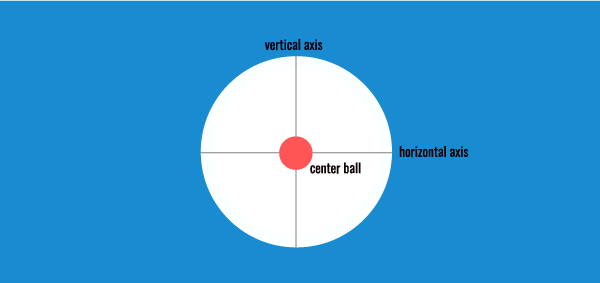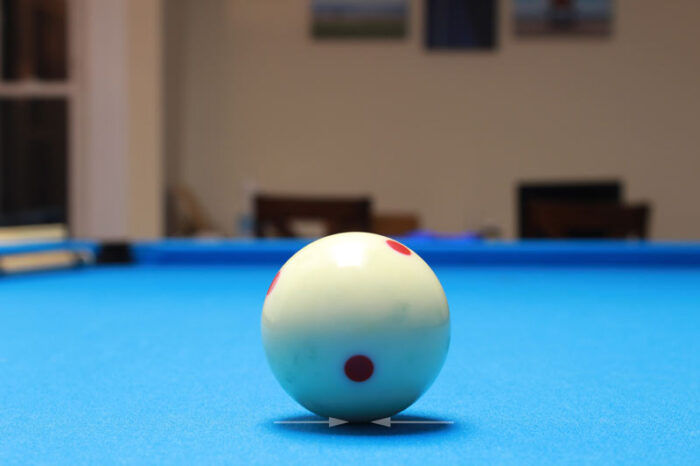All pool games are about controlling your tip when you hit the cue ball to put the kind of spin that you want or don’t want to make the ball your aiming at and have a good leave for your next shot. Adding spin on the cue ball is accomplished by hitting outside the center of the cue ball. This makes it possible to change the path of the cue ball after hitting the ball you’re trying to pocket so you can make your next shot easily.
However, using spin has many unintended consequences for those not familiar with it. Accidentally adding spin to a shot stops you from achieving the primary objective: making the object ball.
“If I feel like I didn’t hit [the cue ball] well I’ll watch the cue ball really quick to see which way it’s spinning because 9 times out of 10 I’ve mishit the cue ball because my alignments good.” – Johnny Archer 2x World 9 Ball Champion
The point here is that a lot of the time you may actually be lining up and aiming the cue ball correctly, but the problem isn’t your aim, but the spin you’re adding to the cue ball. So having the ability to figure out when spin was added on a shot is important, and being able to consistently hit center on the cue ball even more so.
What is Center Ball?
This article is all about center ball, but I haven’t actually described what center ball is. Part of the reason for that is it is somewhat self explanatory, but not completely. I remember when I first started learning how to play center ball seemed like a nebulous concept that I understood to a marginal degree. The reason for that is center ball can mean two things
- Hitting the cue ball in the center of the horizontal and vertical axis of the cue ball
- Hitting the cue ball in the center of the vertical axis of the ball
The purpose of this article is to focus on the first definition of center ball, but the second definition is used regularly when people discuss pool so you should at least be aware of it.
Hitting the horizontal axis of the cue ball from side to side eliminates adding side spin the cue ball. Side spin is one of the biggest causes of missing shots which is what the pro Johnny Archer was pointing out above.

The horizontal axis of the cue ball is when you try to hit the center of the ball between top to bottom. Hitting higher or lower than center adds top or back spin which change the direction of the cue ball after hitting the object ball. Hitting high or low on the cue ball don’t have the same draw backs of side spin which makes those types of spin really useful for getting position on shots without adding complexity to the shots.
Why is center ball important?
Some of these points have already been touched upon, but you should be able to find center ball because it increases the number of balls you make at the table. Hitting center ball keeps the number of variables you have to keep track of as small as possible because it prevents spin being added to the cue ball.
It eliminates side spin:
And although it sounds like we’re just talking about one variable (spin on the cue ball), spin changes a lot of aspects of every shot:
- The initial direction of the cue ball before hitting the object ball
- The curve of the path the cue ball takes after being struck
- The direction of the object ball on contact with the cue ball
- The direction of the cue ball after it hits a rail
Those are a lot of factors to deal and we talk more about these aspects of spin later, but these are the main factors that change the shot when adding spin. This isn’t to say that spin is bad. Using spin is a huge advantage to anyone who knows how to use it, but before you start to deal with all those factors above, it’s better to make your life easier and eliminate those factors by not using spin and hitting center ball.
It gives us a place to start from when we start adding spin:
One of the biggest challenges I had when I started playing was figuring out when I added side spin to the cue ball and to what degree. I’d get frustrated because I could swear I was adding a certain type of spin to get a specific result, when the truth was I was either hitting center or using the wrong type of side spin entirely.
Learning to identify and use center ball consistently will make learning how to use side spin and top and bottom spin much easier. Because if you can accurately hit the direct center of the cue ball, you can accurately hit any other part of the cue ball as well.
How to find center ball
Eventually you’ll finding center ball will be instinct and you won’t even need to think about it. But if you’re unfamiliar with how to find center ball there’s a couple different ways to find it.
Use the shadow of the cue ball itself:
One method you can try is to use the cue ball itself as an aiming tool. A perfectly round ball will always make contact with the table at the direct center of it’s vertical axis. If a ball isn’t perfectly round this won’t be the case, but when that happens you have whole other problem to deal with. So using the cue ball as your guide, if you check where the cue ball meets the felt you should see a tiny shadow of that on the table. Where that point is, is center of the vertical axis of the cue ball.

Use the number of an object ball as a training tool:
Another method you can try to find the center of an object ball is to find a numbered object ball and use that as a target. If you set up the object ball so the number is centered horizontally and vertically and use that as an aiming point, it should get easier to find that point on a cue ball with no markings over time. And this at least serves as a good starting point until you can find the center of the ball more naturally.
Take the chalk off the tip of your cue stick:
This won’t help with seeing the center of the cue ball, but it helps with feeling the center of the cue ball over time. Since chalk is what allows players to put spin on the cue ball, removing the chalk on your spin will tell you if you hit center or not. Without chalk on your cue you’ll miscue every time you try to hit the cue ball off center. So if while you’re shooting a ball and you miscue without chalk, you know you didn’t hit the center of the ball.
